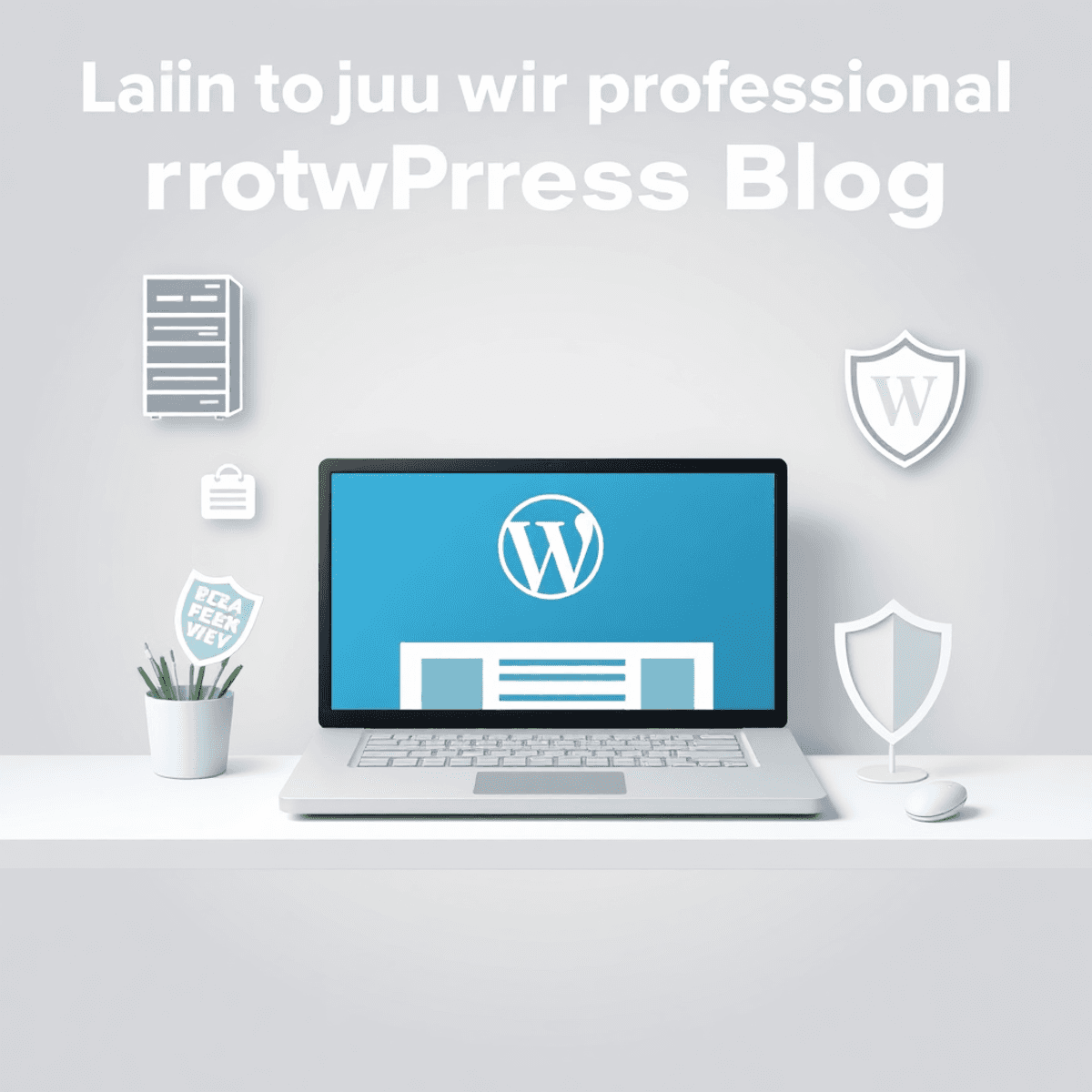Launching a WordPress blog requires a systematic approach to ensure success.
This article serves as your comprehensive guide for setting up a professional WordPress blog.
Save time and implement best practices for SEO, security, and usability effortlessly.
1. Preparing to Launch Your WordPress Blog
Choose and Register Your Domain Name
Start by selecting and registering your domain name. This is the web address visitors will use to find your blog. Choose a domain that clearly reflects your brand or niche, making it easy to remember and type. Avoid long, complicated names or those with confusing spellings.
Secure reliable domain registration from reputable providers that offer straightforward management tools. Register your domain for at least one year to establish credibility with search engines.
Find Optimized Web Hosting for WordPress
Next, focus on web hosting for WordPress optimized for speed and security. Hosting affects how fast your site loads and how well it performs under traffic spikes. Slow or unreliable hosting drives visitors away and harms SEO rankings.
Modern Warrior Sites hosting stands out as a trusted provider tailored specifically for WordPress blogs. Their servers are fine-tuned for optimal loading times and come with robust security measures to protect your site from attacks. Modern Warrior Sites uses Virtual Private Servers for all its hosting plans, unlike most hosts that offer shared hosting, which can risk your site by placing it with many others in the same directory.
Prioritize these factors when choosing a host:
- Speed: Fast servers reduce page load times.
- Security: Features like daily backups, malware scanning, and firewalls keep data safe.
- Customer Support: Access to knowledgeable support staff ensures quick resolution of issues.
Importance of Domain and Hosting Setup
Preparing with the right domain and hosting setup lays a strong foundation before installing WordPress itself. This reduces headaches later and keeps your blog running smoothly from day one.
2. Installing WordPress: The Foundation of Your Blog
Installing WordPress Quickly:
Utilize one-click installers available with most hosting providers to set up WordPress swiftly.
Accessing Your WordPress Dashboard:
Log in to your new WordPress dashboard using secure admin credentials provided during installation.
Initial Configuration Steps:
Perform essential backend setup tasks to prepare for customizing your blog’s appearance and functionality.
3. Choosing and Customizing Your Theme
When choosing a theme for your WordPress blog, focus on simplicity, responsiveness, and speed optimization. A clean and responsive design ensures your site looks great across all devices and provides a seamless user experience.
Recommended free themes
Starting with free themes like Astra and Kadence can be a smart choice. These themes offer a good balance of features and customization options to help you create a professional-looking website without overwhelming complexity.
Basic customization essentials
After selecting a theme, consider customizing it to reflect your brand identity. Upload your logo to establish brand recognition, set brand colors for consistency, and adjust the header layout to enhance visual appeal.
Remember, the theme you choose sets the tone for your entire website, so make sure it aligns with your content and overall brand image.
4. Essential Plugins to Install First
When setting up your WordPress blog, choosing the right plugins is crucial for functionality and performance. Here are some essential plugins every blogger should install:
- Security Plugin: Protect your site from potential threats with plugins like Wordfence or Solid Security. Ensuring the security of your blog is paramount to safeguarding your content and user data.
- Backup Plugin: Backing up your site regularly is a best practice to prevent data loss. Consider using UpdraftPlus to automate backups and restore your site easily in case of emergencies.
- SEO Plugin: Enhance your site’s search engine visibility with plugins like Rank Math or Yoast. These tools help optimize your content for better rankings and increased organic traffic.
- Caching Plugin: Improve your site’s speed and performance by caching resources. WP Super Cache is a popular choice to reduce loading times and enhance user experience.
- Anti-Spam Plugin: Combat spam comments and protect your blog from unwanted intrusions with plugins like Akismet or Antispam Bee. Maintaining a clean and secure environment is key to engaging with genuine visitors.
Remember, while plugins offer great functionalities, it’s important to limit their use to maintain site speed and prevent conflicts. If you opt for hosting with ModernWarriorSites.com, premium plugins for security, backup, SEO, caching, and anti-spam and more are included in their hosting plans for added convenience and reliability.
5. Building Your Site Structure with Key Pages and Navigation
Creating a well-organized website structure is crucial for both user experience and search engine optimization. We will cover the essential pages every blog needs, how to add them to your navigation menu, and setting options for your homepage display.
Must-Have Static Pages for Your Blog
Every blog should have the following static pages:
- Home: This is the main landing page of your blog where visitors will first arrive.
- About: Use this page to introduce yourself or your brand and share your story. Learn how to create an About page on WordPress.
- Contact: Provide a way for your readers to get in touch with you through this page.
- Privacy Policy: This page outlines how you collect, use, and protect user data. Here’s how to set up a Privacy Policy page.
- Terms of Service: If applicable, include this page to explain the rules and guidelines for using your website.
Adding Pages to Your Navigation Menu
To ensure easy access and professionalism, it’s important to add these key pages to your navigation menu. Here’s how you can do it:
- Log in to your WordPress dashboard.
- Go to “Appearance” and click on “Menus.”
- Select the menu you want to edit or create a new one.
- Add the static pages (Home, About, Contact, Privacy Policy, Terms of Service) by checking the boxes next to them.
- Click on “Add to Menu” and arrange the order as desired.
- Save the menu.
Setting Homepage Display Options
Deciding whether to display a static page or a blog roll as your homepage is another important aspect of site structure. Here’s how you can set it up:
- From your WordPress dashboard, go to “Settings” and click on “Reading.”
- Under the “Your homepage displays” section, choose either “A static page” or “Your latest posts.”
- If you select “A static page,” choose the specific page you want as your homepage from the dropdown menu.
By implementing these strategies for building your site structure with key pages and navigation, you’ll create a user-friendly experience that also benefits search engines.
6. Optimizing Settings for SEO and Usability
Configure your WordPress permalinks to use the “Post Name” structure. This setting creates clean, SEO friendly URLs that improve search engine rankings and user readability. Navigate to Settings > Permalinks, select Post name, and save changes.
Adjust your site’s core identity under Settings > General:
- Site Title: Reflects your brand or blog name; appears in browser tabs and search results.
- Tagline: A concise description supporting your title; enhances branding clarity.
- Timezone: Set according to your location for accurate post timestamps and scheduling (set timezone WordPress settings).
Remove default WordPress sample content such as the “Hello World” post and sample page. This avoids clutter and confusion when publishing your own content.
These steps form an essential part of your Checklist For Creating A WordPress Blog. They establish a solid foundation for SEO success and consistent usability across your site.
7. Testing Your Website on Multiple Devices and Securing It
Checking Site Appearance: Before launching your WordPress blog, it’s crucial to test how your site appears and functions on both desktop and mobile devices. Ensuring a seamless experience across all platforms is essential for user satisfaction.
SSL Activation: Activating SSL (Secure Sockets Layer) on your website is vital to ensure secure data transmission. By enabling HTTPS, you build trust with visitors and protect sensitive information exchanged on your site.
Bookmarking Login URL: To streamline future access to your WordPress dashboard, consider bookmarking the login URL. This quick access can save time when you need to make updates or modifications to your site.
By addressing these key points, you can enhance the user experience, bolster security measures, and streamline website management for optimal performance.
8. Moving Forward After Setup: Content Creation and Growth Strategies
Focus on content creation tips WordPress blog that resonate with your target audience. Start by launching your first posts with clear, valuable information addressing their specific needs or pain points. Quality content builds authority and encourages repeat visits.
Implement email list building strategies to grow your subscriber base effectively:
- Use lead magnets like the free guide “99 Tips for Building a Functional Website” to attract sign-ups.
- Place opt-in forms strategically on your site—consider pop-ups, sidebar widgets, and at the end of blog posts.
- Highlight the benefit of your newsletter clearly: exclusive tips, updates, or resources tailored for readers.
- Assure visitors their privacy is respected; explicitly state you do not share personal data.
Consistent content delivery combined with thoughtful email marketing transforms casual visitors into loyal subscribers. Track engagement metrics and adjust your strategies based on what content drives signups and reader interaction.
Focus efforts on building relationships through newsletters while maintaining transparency about data usage. This approach fosters trust and long-term growth for your WordPress blog.
Why Choose Modern Warrior Sites For Hosting & Web Services?
Optimized Performance: Modern Warrior Sites offers optimized performance specifically designed for WordPress blogs, ensuring fast loading times and efficient functionality.
Excellent Customer Support: Tailored towards bloggers and small business owners, the customer support provided by Modern Warrior Sites is reliable and responsive to your needs.
By choosing Modern Warrior Sites as your hosting provider, you can benefit from their focus on performance and customer satisfaction, making it an ideal choice for launching and maintaining a successful WordPress blog.
Conclusion
Ready to share your thoughts and ideas with the world? Launch your WordPress blog today and start your blogging journey! With our comprehensive checklist for creating a WordPress blog, you’ll have everything you need to set up your site and start publishing content.
But remember, having a great hosting provider is crucial for a smooth setup and ongoing support. That’s why we recommend Modern Warrior Sites for all your hosting needs. Their reliable services and expert support will ensure that your blog runs smoothly, allowing you to focus on what you do best – creating amazing content!
Don’t wait any longer. Take the first step towards becoming a successful blogger and launch your WordPress blog today with Modern Warrior Sites!




